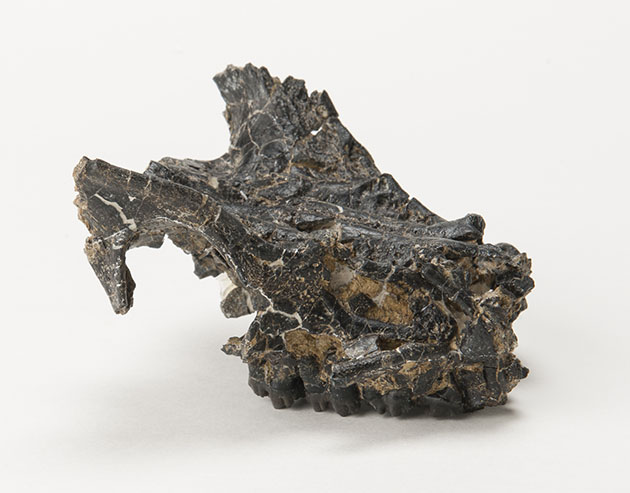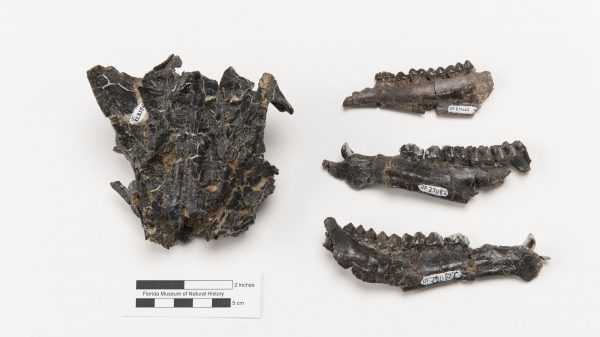
Florida Museum photo by Kristen Grace
The expansion of the Panama Canal, a century-old waterway connecting the Atlantic and Pacific, began with a massive explosion bursting through more than 20 million years of rock and sediment. For Aldo Rincon and other Florida Museum of Natural History paleontologists, it was the sound of opportunity.
That same year, 2007, Rincon left a career as an economic geologist in Colombia to intern for former University of Florida doctoral student and paleobotanist Carlos Jaramillo of the Smithsonian Tropical Research Institute, and immediately began excavating newly exposed layers of earth and collecting fossils.
“When I was a kid, my room was always full of rocks,” Rincon said. “I’d been interested in fossils since I was a little child and it was the right time in my life to make a change.”
It was during those early days of excavations in the canal that Rincon collected his first specimen of Paratoceras—an extinct deer-like herbivore with peculiar head ornaments similar to a giraffe’s horns. He has returned to Panama numerous times over the last eight years and unearthed more remnants of the ancient mammal, including jawbones and sections of skull.
“These guys had a strange appearance and were part of a herbivorous group of early deer-like animals called protoceratids, which appeared in the North American continent about 40 million years ago and went extinct about 5 million years ago,” Rincon said, examining the rearticulated jaw of P. coatesi. “Paratoceras represents one of the most compelling examples of a tropical endemic animal you can find in ancient Central America, modern day Mexico, southern Texas and Panama.”
Rincon and co-authors describe recently discovered fossils of Paratoceras, including the new species P. coatesi and P. orarius, in an August 2015 study appearing in the Journal of Vertebrate Paleontology. Rincon found the new fossils while working with the Florida Museum Panama Canal Project-Partnerships for International Research and Education. The fossils from the early Miocene (20 million years ago) suggest early pioneer animals colonized Panama during that time. Intense volcanic activity marked Panama’s terrain during the early Miocene and all of southern Central America was likely a peninsula with volcanic islands connecting tropical areas of Panama with the modern day Gulf Coast of the southern United States and Mexico.

Florida Museum photo by Kristen Grace
The Isthmus of Panama, which connects North and South America as we know it, did not exist when Paratoceras first inhabited Central America’s tropics. But animals could walk from North America to Panama at the time and probably keep their feet dry, Rincon said. His research aims to show that 18 million years before the formation of the Isthmus, there was already a continuous connection between the tropics and North America.
Paratoceras was one of the first hoofed mammals to settle in Panama’s formidable tropical landscape, Rincon said. Scientists want to better understand the origins of modern tropical biodiversity and Paratoceras is helping them do that by offering a glimpse at an early pioneer animal during a time crucial to the structuring of modern tropical diversity.
“Early interpretations by scientists held that the tropics may operate as a source of diversity, like a cradle of life of sorts,” Rincon said. “We initially thought species showed up in the tropics and later they moved to the North. Today, with all the new discoveries from the Canal expansion areas, we know that it was more complicated than that. They came to the tropical forests of Panama from northern areas of North America where interactions between climate change and carbon levels sped up diversity.”
Although Paratoceras only existed until the late Miocene, “a profound deterioration of the climate 5 million years ago, a crisis that also affected numerous terrestrial animals, could be the explanation of the extinction all of the protoceratids,” Rincon said.

Florida Museum photo by Kristen Grace
The study supports Rincon’s previous work, which found that despite Central America’s close proximity to South America there was no connection between continents, because mammals in the area 20 million years ago, like Paratoceras, all had North American origins.
Though Paratoceras once inhabited tropical and subtropical areas of Central America, it has not been found in the Miocene fossil record in Florida and the Great Plains.
“By looking at the locations of fossils of different species within the genus Paratoceras throughout its existence, study researchers hypothesize it may have diversified in tropical areas like Panama during the early Miocene and later colonized more subtropical areas of southern Texas during the late Miocene,” Rincon said.
The study provides more information about the distribution of mammals in the ancient tropics, areas that are still incredibly diverse today though little is known about their past due to dense forests that prevented paleontological excavations in the area prior to the Panama Canal expansion project, Rincon said.
“Better understanding of early immigrants like Paratoceras will allow us to visualize the evolution through time of tropical diversity,” Rincon said. “The evolutionary origins of this biodiversity goes deep back in time, since terrestrial animals have been elements of the tropics for almost 20 million years.”
Rincon’s overall research goal is to explain the evolutionary history, interaction and relationships of ancient camels, horses and deer-like animals that inhabited the tropics. He also hopes this research will help scientists better understand the geographic connection of tropical species with other fossil mammals found in North America. Eventually, Rincon hopes to return to Colombia where there is a shortage of paleontologists to train young paleontology enthusiasts.
But the work Rincon has undertaken isn’t easy.
“In some places, like the Great Plains, a paleontologist can spend a few weeks there and find a thousand fossils,” he said. “In Panama, we’ve spent more than four years there and found only a couple hundred. Sometimes I wonder if I made the right decision years ago, because it is a difficult job. You have to be lucky. And you need to focus your energy on the right places at the right time. But, I guess you could say I’m stubborn,” he said smiling as he worked in his lab.
Learn more about the Vertebrate Paleontology Collection at the Florida Museum.